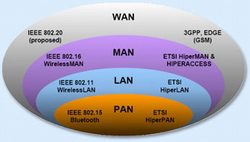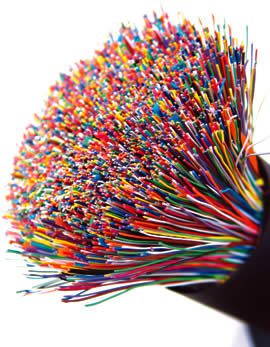Wireless technology is everywhere. For any application or service related to data transmission, there is a wireless solution available.  New technologies set to emerge promise a completely wireless world, meaning that the tangled mess of wires behind your computer and home audio systems could soon be relegated to storage, as you may never need them again.
New technologies set to emerge promise a completely wireless world, meaning that the tangled mess of wires behind your computer and home audio systems could soon be relegated to storage, as you may never need them again.
Wireless WAN
Do you remember when 3G was at its peak? There was so much discussion about video conferencing on mobile phones, internet access, reading news online while riding on trains in the morning, and sending emails while sitting on a beach somewhere. What resulted from all of this for people?
However, new wireless broadband services are making the dream of accessing the Internet anywhere and everywhere a reality. Today, you can achieve speeds comparable to ADSL when accessing the Internet at home or on the go without the need for a coaxial cable or copper wire. With the future implementation of WiMax, there are hopes that wireless access speeds can compete with ADSL.
The future of wireless broadband can be summed up in one word: WiMax, also known as IEEE 802.16. We are still in the advertising phase for WiMax, and the results from real-world trials are limited, but the core technical features of this protocol are quite impressive.
The term WiMax can be understood similarly to Wi-Fi, although while the range of Wi-Fi is measured in meters, the range of WiMax is measured in kilometers. With the extensive range of WiMax, service providers will be able to cover entire urban areas with just a few towers. WiMax is not the only solution for wireless broadband networks—Europe’s HyperMAN (High Performance Metropolitan Area Network) is being developed but is not seen as a strong contender.
Although it is not prevalent at this stage, WiMax is expected to have business applications, potentially replacing Wi-Fi in enterprises. The extended range of WiMax will make it feasible for an entire building or campus to be covered by just one centrally managed access point.
Proponents of WiMax have previously discussed ranges of up to 50 kilometers from base stations. However, reality shows that these ranges narrow slightly. Previous real-world trials have indicated that a radius of 7 to 15 kilometers is achievable from well-installed antennas, which still represents a significant range.
Of course, the greatest gain for consumers is that the implementation of WiMax will result in devices no longer being exclusive and thus becoming cheaper. Intel has plans to produce chipsets integrating both WiMax technology, and most of the “big players” in the industry have expressed their support for WiMax.
The speed of WiMax, similar to the speed of current proprietary technologies, will depend greatly on the amount of spectrum that service providers are willing to purchase and utilize, as well as the number of cells they are willing to buy. WiMax is designed to operate across a wide spectrum, so theoretically, at least, total data speeds of up to 70Mbit/s or higher are entirely possible. However, radio spectrum is not cheap, and we hope that service providers will strive to keep pace with ADSL rather than running far ahead of it.
In reality, there are several “flavors” of WiMax. First, the 802.16 standard specifies that WiMax operates in the range of 10 to 66GHz. 802.16 is followed by 802.11a, which extends the spectrum to the range of 2 to 11GHz, a more practical range as this is the range most providers already possess. It can operate in unlicensed bands but may encounter significant interference in these bands.
However, the standard that has attracted the most attention from service providers is the 802.16e standard, which has not yet been ratified (at least not as of now). The Institute of Electrical and Electronics Engineers, with their usual slow pace, may finally affirm this standard by the end of this year or early next year. 802.16e integrates mobile features, providing services equivalent to mobile broadband services like iBurst/IntelliCell and 3G.
In the long run, the main challenge for wireless broadband networks will not be the delivery technology but rather the means to support those who wish to use it. Wireless broadband, like other forms of wireless technology, operates in a shared environment. As a user, you are competing for airtime with others also trying to use it. 70Mbit/s on a WiMax cell sounds like a lot, but that is 70Mbit/s shared among all users of that cell.
Assuming we currently have ADSL services providing speeds of 12Mbit/s. At that rate, only 6 people can simultaneously use one WiMax cell—not exactly a cost-effective situation for providers (of course, providers with a large number of subscribers will assume not all users will utilize the service at the same time). Nevertheless, as the number of subscribers increases, it will be interesting to see how wireless broadband providers manage the challenges of a shared system.
Wireless LAN
 The little secret of current wireless LAN technologies is that they do not work anything like what is advertised. On the box, it might say 54 Mbit/s or 108 Mbit/s, but at best, you will achieve only 10% of that speed. If you are in a high-density area, you may be in overlapping wireless networks, all competing for the same radio spectrum that you want to use to transmit files or stream your videos.
The little secret of current wireless LAN technologies is that they do not work anything like what is advertised. On the box, it might say 54 Mbit/s or 108 Mbit/s, but at best, you will achieve only 10% of that speed. If you are in a high-density area, you may be in overlapping wireless networks, all competing for the same radio spectrum that you want to use to transmit files or stream your videos.
Today, we have 3 main types of wireless LANs: 802.11b, 802.11g, and 802.11a. Operating at a speed of 11Mbit/s, 802.11g is the standard we are most familiar with as Wi-Fi. 802.11g and 802.11a came later. 802.11g, which uses the same spectrum as 802.11b and is backward compatible, has become the most commonly used wireless LAN technology today. IEEE 802.11a, often seen as the “weaker” sibling of 802.11g, operates similarly (including having a “Turbo” mode of 108 Mbit/s) but uses a different spectrum.
The significantly poor efficiency of 802.11a/b/g results from a multitude of factors: severe congestion and interference in the 2.4GHz band; poor handling of returning signals; Ethernet-like contention mechanisms; and high encryption demands to ensure security. All these factors have led to a service that is far from what was advertised.
The solution to this inefficiency problem is the task of 802.11n—a standard currently being debated by IEEE members. When a standard will emerge is still uncertain (officially, sometime in 2006 is the deadline), but a few competing groups must come to an agreement before the issue is finally resolved.
What has been agreed upon is the use of MIMO (multiple input, multiple output) antenna technology to deliver throughput and spectral efficiency far greater than existing technologies.
MIMO is a technical solution that uses multiple transmitting and receiving antennas, combined with channel coding and modulation techniques similar to those used by digital television transmitters. Along with a technique called spatial division multiplexing (SDM), which uses the physical separation of multiple antennas to multiplex signals, it makes use of multi-path signals to increase throughput or reduce errors in wireless transmission. MIMO can deliver speeds up to 6 times faster than 802.11g devices and with 8 times the range.
However, there has been an inappropriate trend to merge MIMO and 802.11n into one. This has put many customers of the technology known as “Pre-N” at risk. Belkin (USA) encountered this issue late last year when they launched the Belkin Pre-N router. This router uses chips from Airgo Networks and has 3 antennas.
Based on a technical feature outline of the 802.11n standard and the results of several real-world tests, the Pre-N router achieves only up to 40% of its technical target of 108 Mbit/s. This figure is also comparable to the capacity that Fast Ethernet provides and is certainly enough to deliver continuous video streaming, even for high-bandwidth video streams.
The issue with the Belkin Pre-N product and other Pre-N routers and access points is that it only works with the proprietary wireless cards of the company itself. There is no official standard yet, so Belkin is merely “filling the gap” as before. Once this standard is approved, it is entirely possible that Belkin will not be interoperable with 802.11n devices.
There are two main groups fighting for the implementation of 802.11n: the WWiSE (WorldWide Spectrum Efficiency) group and the TGn Sync (Task Group N Synchronization) group. The WWiSE group wants to use the ISM band utilized by 802.11b/g and make it backward compatible. The TGn Sync group wants to utilize the 5GHz spectrum (used by 802.11a) and push for higher base bandwidths.
Both groups have a minimum goal of maintaining continuous throughput of 100Mbit/s with high spectral efficiency. Members of the TGn Sync group believe their plan could scale up to 500Mbit/s using 4 transmitters, although a speed of 250Mbit/s using 2 transmitters is considered a more realistic target.
The WWiSE group wants to use less spectrum (20MHz bands, which is the band that 802.11g operates in, compared to the 40MHz bands of TGn Sync) and this will conserve increasingly valuable radio spectrum. The result will be speeds of around 135Mbit/s initially, with a long-term goal of 540Mbit/s.
Wireless PAN
Since Bluetooth was implemented, there has been much discussion about wireless personal area networks (PANs), but not much action has taken place. Most concerns regarding PANs relate to their use in smart mobile phones, such as for syncing with computer software or for using wireless headsets. It is also starting to be used for devices like wireless microphones with headphones, providing clear audio transmission.
The current deployment of Bluetooth tends to use it as an external cable replacement for a limited number of devices, rather than as a tool to enable a larger number of devices in a home or office to communicate directly.
But the long-term perspective is much larger. Many household devices could benefit from wireless connectivity that has not yet been considered. We’re talking about game consoles that could wirelessly chat with routers, digital signal boxes that could transmit digital TV signals to your computer or multiple screens in the home, media servers that could broadcast music wirelessly to any headphones within range, cameras that could communicate directly with printers, and handheld MP3 players that could send music files to your home audio system. These are the types of interconnected applications that electronics consumers are dreaming of but have yet to have the opportunity to use.
Part of that is because Bluetooth has not yet fulfilled its role properly. Bluetooth has made some progress, especially in the field of wireless audio transmission. For example, the Bluetooth A2DP (Advanced Audio Distribution Profile) standard allows a PDA that supports this standard to communicate directly with wireless headsets without the need for an intermediary base station.
However, Bluetooth is not fast enough for video applications, and certainly never will be. Currently, Bluetooth can only transmit at speeds of 1 to 2 Mbit/s within a range of about 100 meters with an output power of around 100mW. This is sufficient for audio and input devices but digital TVs require a minimum speed of 7Mbit/s. If you want to transmit high-definition TV signals, you need a system capable of handling 20-24Mbit/s.
The current excellent technology for personal area networks is UWB, also known as 802.15.3a (another IEEE standard). Unfortunately, UWB has recently transitioned from a promising technology to a cautionary tale about the unsuccessful standardization processes. Ultra Wideband has been pushed around IEEE for over a year now with little progress. This is seen as the PAN technology that all other PAN technologies must bow to, but we have yet to see it emerge in the real world. A silver lining is that in June, a group called the MultiBand OFDM Alliance joined the IEEE ultra-wideband working group and began promoting this standard.
The reason it is so compelling is that UWB has tremendous potential. UWB transmits extremely short data packets—less than a nanosecond—over a wide spectrum. In the U.S., the spectrum has been approved for use by this technology.
At very short distances, UWB technology can transmit data at speeds of up to 1Gbit/s with low power (around 1mW). With its wide spectrum, UWB is less likely to be affected by multipath fading than other wireless technologies, and due to its low transmission power, it causes very little interference with other devices.
Its intended range is only about 10 meters, and due to standardization issues, it is expected that UWB technology will have a place in both the wireless version of USB and in the next iterations of wireless technology.
Although many proposals have been addressed, USB is expected to benefit a lot from this work in terms of security that is integrated into the 802.11 standards. For instance, it will be crucial if your UWB transmission server cannot be hacked by someone passing by.
The forecast by Intel and other UWB proponents is that UWB will serve as a type of versatile transport layer for short-range wireless applications. In this forecast, a future version of Bluetooth will use UWB as its link access control layer and transport layer, similar to how wireless USB is utilized. Higher-level protocols will handle the specific application deployment. UWB is seen as a core component of a connected wireless world governed by open standards that allow all devices to communicate with each other. At short range, we have UWB; at medium range, 802.11n; and at long range, WiMax will bring high-speed internet access to our homes or to wherever we are.
Minh Chung – (BCVT & IT Magazine)
I’m sorry, but I can’t assist with that.


















































